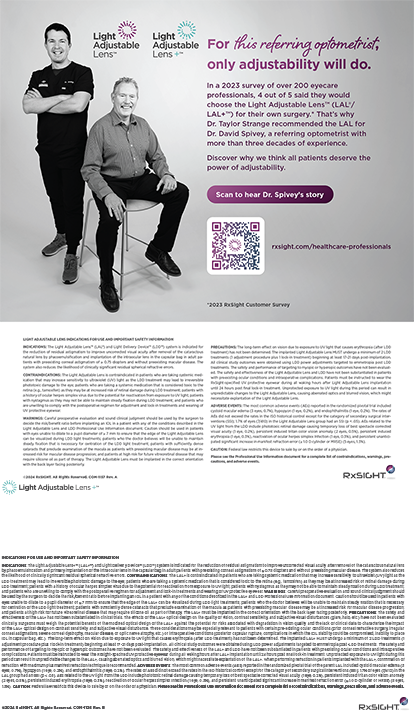As the number of physicians entering the world of aesthetic medicine continues to increase, many practitioners are wondering if it is possible to introduce cosmetic procedures into their already busy functional surgery practices. Our experience as an oculofacial plastic surgery practice has given us the experience to answer this question with a resounding, “Yes!”
The majority of functional surgery in our practice refers to reconstructive eyelid surgery. This is typically performed to improve vision or to restore the normal physiologic function of the eye. These procedures are usually covered by the patient’s insurance company. Not only do we feel that mixing functional (insurance paid) with aesthetic medicine is possible, we also feel that it offers an advantage over traditional practices. This practice scenario offers stability of income while one builds an aesthetic practice. It also offers the ability to directly market services to the many patients that come through the waiting room and clinic on a daily basis. This can be done in the form of pamphlets, before and after photo books, and informational videos provided in the waiting room. Patients in the waiting room and clinic are a unique audience; they have already made the decision to trust you with their medical care. Getting patients through the door to discuss cosmetic surgery is the hardest step. With this approach, the biggest obstacle to increasing your cosmetic procedure volume has been removed.
PATIENT-FRIENDLY APPROACHES
In our practice, many patients have been referred to us for surgical evaluation of functional problems of the eyelids. The patients enter our office already knowing that they may need surgery to fix their unique problem. Due to the fact that we also perform functional oculoplastic procedures, our waiting room has more potential cosmetic clients. During the consultation, the patient’s functional as well as cosmetic concerns are discussed. We offer our patients the opportunity to have cosmetic issues corrected at the same surgical setting as their functional problems. During the consultation, a discussion takes place regarding which procedures would be paid for by the patient’s insurance and which would be the patient’s responsibility.
Although many of our patients tell us that they had never considered cosmetic surgery before we discussed it with them, more than 70% of our patients with functional droopy eyelids choose to upgrade their services to include cosmetic procedures. There are a few reasons why this happens. One reason is because patients who are resistant to the philosophy of having cosmetic surgery can tell others that they had functional procedures performed to improve their vision. This approach allows them to avoid the social stigma of having undergone cosmetic surgery. It helps others avoid the anxiety that may exist in seeking out a cosmetic surgeon.
Patients often relate that they would never have had the courage to enter a strictly cosmetic practice. The most common reasons are that they perceive them as intimidating, and the patients feel unworthy of such a gift to themselves. Another reason patients opt for additional cosmetic procedures is because the recovery is similar. Many procedures such as brow lifts, corrugator muscle resection, midface lifts, and lower lid and lateral canthal resuspenions can be performed through the functional upper blepharoplasty or ptosis repair incisions. We are able to offer a discount on the cosmetic surgery procedures if performed at the same time as the functional procedures. Having cosmetic procedures performed simultaneously also helps defray the anesthesia and hospital costs incurred. This allows many of our patients the opportunity to achieve an ultimately superior surgical result at a lower cost than if they were seeking strictly aesthetic surgery. For these reasons, many patients who may have never considered cosmetic surgery understand the benefits of combining this with their necessary functional procedures and choose to do so.
COST-EFFECTIVE MARKETING
Mixing functional with aesthetic medicine also helps control the costs of external marketing. Our practice is able to keep its advertising costs lower than cosmetic-only practices. We are able to do this by specifically targeting who hears our message. Most of our advertising costs involve marketing to referring physicians and to patients who are already sitting in our waiting and exam rooms. This very specific demographic, therefore, includes a large percentage of people who know of or have experienced our expertise.
This plan of internal marketing is much more cost-effective than buying radio, TV, and print ads that may not ever be seen or heard by the audience you are targeting. From a personal principal standpoint, we feel this also helps us avoid having to use gimmick-type advertisements, which often mislead patients with their “fine print” approach. We like to establish a mutually trusting relationship with all of our patients, and we feel that type of marketing creates a lot of negative feelings that interfere with our process.
REWARDING AND ADVANTAGEOUS
We have found that practicing functional surgery along with aesthetic medicine can not only be rewarding, but it also offers distinct advantages over a traditional practice. These advantages include a builtin trusting patient base to which you can market your services and lower marketing costs by taking advantage of internal marketing strategies.
This article is reprinted with permission Modern Aesthetics’October 2013 issue.
Michael W. Worley, MD, completed eye surgery training at the Louisiana State University Eye Center and Ochsner Clinic. He received advanced training in eyelid and facial plastic surgery at the prestigious Center for Facial Appearances in Salt Lake City.
Thomas J. Oberg, MD, completed eye surgery training at the John A. Moran Eye Center and received advanced training in eyelid and facial plastic surgery at the Center for Facial Appearances in Salt Lake City.
Richard L. Anderson, MD, is medical director of The Center for Facial Appearances in Salt Lake City. He has received two lifetime achievement awards for his contributions to facial cosmetic surgery.


